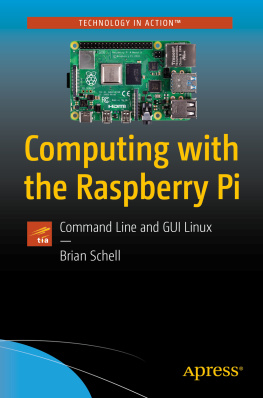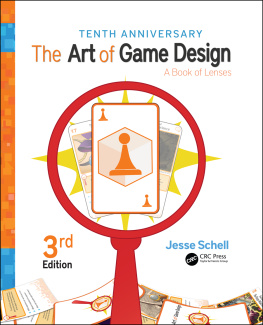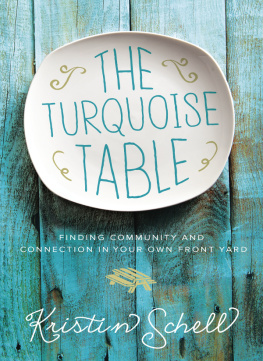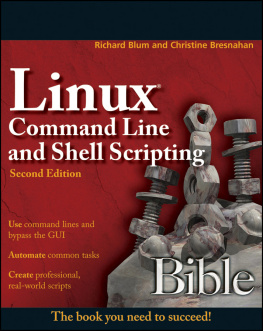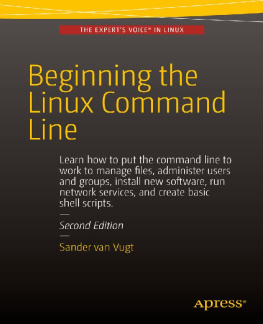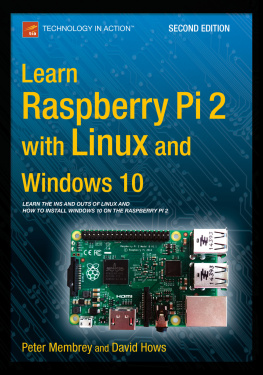Schell - COMPUTING WITH THE RASPBERRY PI: command line and gui linux
Here you can read online Schell - COMPUTING WITH THE RASPBERRY PI: command line and gui linux full text of the book (entire story) in english for free. Download pdf and epub, get meaning, cover and reviews about this ebook. year: 2020, publisher: Apress, genre: Home and family. Description of the work, (preface) as well as reviews are available. Best literature library LitArk.com created for fans of good reading and offers a wide selection of genres:
Romance novel
Science fiction
Adventure
Detective
Science
History
Home and family
Prose
Art
Politics
Computer
Non-fiction
Religion
Business
Children
Humor
Choose a favorite category and find really read worthwhile books. Enjoy immersion in the world of imagination, feel the emotions of the characters or learn something new for yourself, make an fascinating discovery.
- Book:COMPUTING WITH THE RASPBERRY PI: command line and gui linux
- Author:
- Publisher:Apress
- Genre:
- Year:2020
- Rating:3 / 5
- Favourites:Add to favourites
- Your mark:
- 60
- 1
- 2
- 3
- 4
- 5
COMPUTING WITH THE RASPBERRY PI: command line and gui linux: summary, description and annotation
We offer to read an annotation, description, summary or preface (depends on what the author of the book "COMPUTING WITH THE RASPBERRY PI: command line and gui linux" wrote himself). If you haven't found the necessary information about the book — write in the comments, we will try to find it.
COMPUTING WITH THE RASPBERRY PI: command line and gui linux — read online for free the complete book (whole text) full work
Below is the text of the book, divided by pages. System saving the place of the last page read, allows you to conveniently read the book "COMPUTING WITH THE RASPBERRY PI: command line and gui linux" online for free, without having to search again every time where you left off. Put a bookmark, and you can go to the page where you finished reading at any time.
Font size:
Interval:
Bookmark:
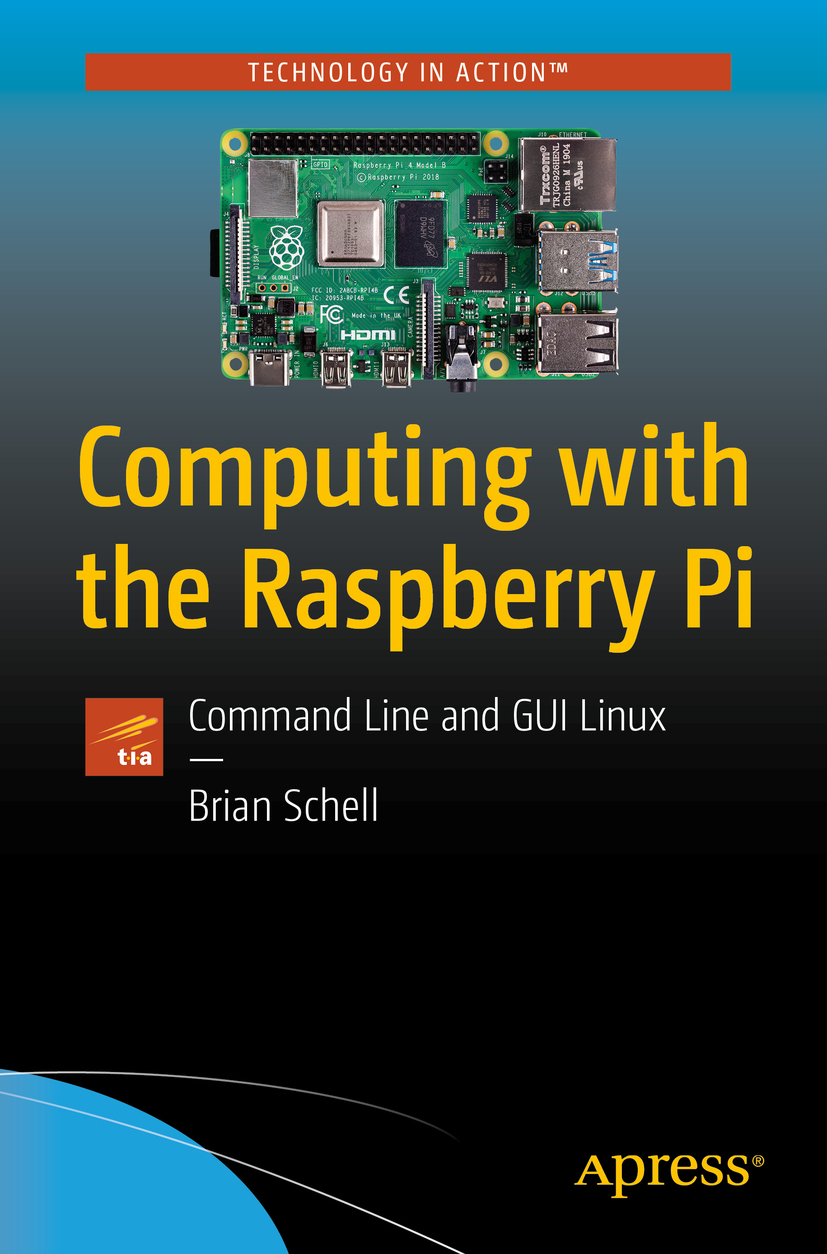

Any source code or other supplementary material referenced by the author in this book is available to readers on GitHub via the books product page, located at www.apress.com/978-1-4842-5292-5 . For more detailed information, please visit http://www.apress.com/source-code .
Remembering my first computer: a Sinclair ZX81.
The Raspberry Pi costs one-fifth as much and is a million times more powerful.
More and more, minimalism is becoming the way of life for a lot of people. Minimalism doesnt mean poverty; it means efficiently doing more with less. Less clutter, less junk, less debt, less stress, and generally less on our minds. Who wouldnt want that? There are even very successful shows on TV about decluttering your life and making your household simpler by eliminating the things that dont make you happy. We can all benefit by making a lower ecological footprint, incurring less debt, and not by chasing the Joneses.
This book isnt about cleaning up your house. Its about cleaning up your technology, or at least in learning how to do all the same stuff you already do in as minimal a way as possible. If youre used to working from a $2500 MacBook Pro, or if you have three iPads in your living room, and youre just waiting for the next new phone upgrade, then I may be talking to you. We all love expensive new high-tech toys, but its a lot of fun going the other direction as well. Whats the least equipment you need to get by?
The first thing that comes to mind is by using older equipment. You can buy used computers on dozens of web sites, and thats always an option. Still, theyre old equipment, theyre used, and who knows how reliable they are after the previous owner didwhatever with them? I always prefer new equipment, but I just dont want to spend a lot of money. I like configuring that equipment to my specifications and making it all work my way.
What kind of computer can we get thats new, but really inexpensive? Well, junk computers usually. You can buy a cheap, new Windows laptop for $200, but it will come preloaded with a ton of bloatware, run slowly, and make the user experience worse than nothing. Chromebooks are an awesome concept, and theyre very powerful in themselves with little cost, but theres almost no customization possible, and they are also closely intertwined with cloud computing, which has its own drawbacks. These obvious solutions arent really solutions at all, they just create new problems. Were going to have to look off the mainstream path for what we want.
I suggest the Raspberry Pi (RPi). This little computer has a quad-core processor, more USB ports than any MacBook made today, and it runs many different varieties of Linux, the most stable free operating system in use today. And best of all, its really, really inexpensive for new hardware.
Why the Raspberry Pi over one of the many newer all-in-one single-board computers that have sprung up since the Raspberry first hit the market? Why not an Arduino, BeagleBone, Odroid, Tinker Board, RockPro, or even Le Potato? Yes, that last one is a real product. Those are all powerful little computers that have their purpose. The Arduino is great for electronics applications that need a microcontroller. The Tinker Board is good for, well, tinkering. The Raspberry Pi, however, can do all these things in a very general-purpose way; what we are looking for in this book is a small device that can serve as a general-purpose computer, and in my opinion, the Pi is the best all-around device for this. Theres a reason so many of these competitors look just like a souped-up Raspberry Pi: because they are. They took the best and bumped it up a little. By sticking with the established Pi architecture, you get the benefit of the most tested and evolved selection of software. Many of those other devices require you to compile the operating system and jump through hoops just to get a working system; the millions of Pi hobbyists have done all that for us already. Many of the apps we will look at here, especially on the desktop side, are simply not available for many of these other devices.
Although all the advertising for Raspberry Pi points out that "Its only $35," thats not strictly true, as this cost is just for the main motherboard. Youll also need a power supply, memory card, a case of some kind, and a few cables. You can pick up the parts individually quite easily, or there are kits that have everything you need for around the same price. Assuming you can scrounge up your own keyboard, mouse, and monitor, youll still only be out of pocket fifty to sixty dollars USD for the other parts.
Most books on the Raspberry Pi focus on programming, hardware tinkering, and electronics interfacing. Not this book. We wont deal with the GPIO port at all, nor will we do any coding of any kind here. In this book, well look at setting up a Raspberry Pi with the intention of using it as a real computer. Well install real desktop software and do real work on it. Then well look under the hood and learn all the command-line tools that will really make things speed along and do things you wouldnt dream you could do with such a small device. Are there limits to what we can do with this little computer? Yes, and thats where the challenge comes in. Itll be fun, itll be inexpensive, and itll be minimalist computing in the extreme!
Font size:
Interval:
Bookmark:
Similar books «COMPUTING WITH THE RASPBERRY PI: command line and gui linux»
Look at similar books to COMPUTING WITH THE RASPBERRY PI: command line and gui linux. We have selected literature similar in name and meaning in the hope of providing readers with more options to find new, interesting, not yet read works.
Discussion, reviews of the book COMPUTING WITH THE RASPBERRY PI: command line and gui linux and just readers' own opinions. Leave your comments, write what you think about the work, its meaning or the main characters. Specify what exactly you liked and what you didn't like, and why you think so.

